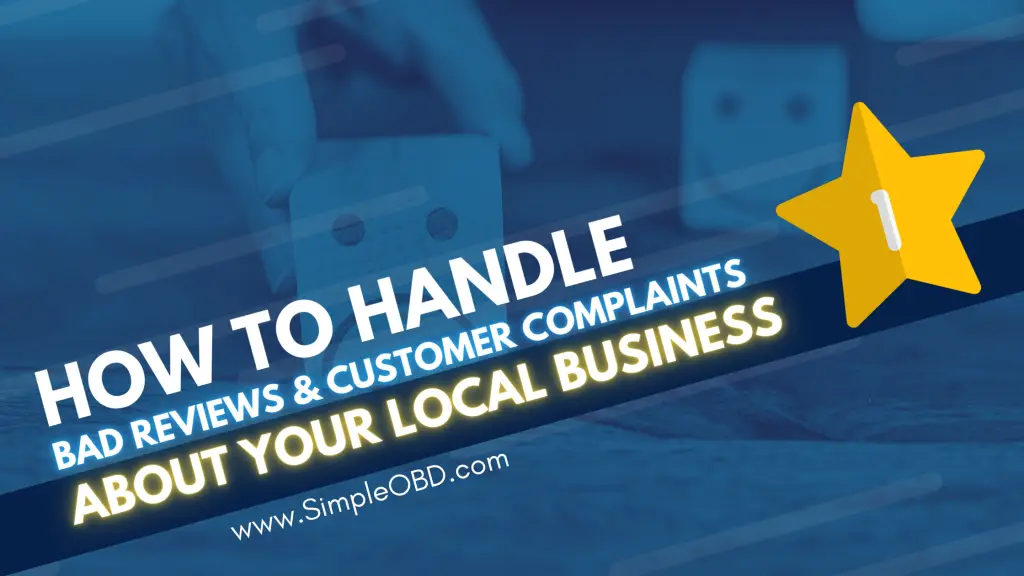
How to Handle Customer Complaints About Your Local Business
Customer complaints are a reality of running any business. While receiving negative feedback can be unpleasant, it can be helpful for making improvements to your company practice and ability to hold onto customers.

Is there a way you can lessen the sting of negative reviews by people who take time out of their day to complain about your product or services?
Yes. Acknowledge them!
When a customer feels heard, they will more than likely go away happy- even if not satisfied with what was done in response. The whole point is to respond.
Best-case scenario, your customer may even have a more positive view of your business after a complaint is resolved simply because you acknowledged it.
What Are Customer Complaints?
In business, there is always a chance that a customer will be disappointed with the product or service delivered. This alone can lead to customer complaints and negative reviews overall.
Customer complaints demonstrate that there may be a possible mismatch between the product or service delivered and the customer’s initial expectations. Although you can’t manage expectations, you can acknowledge complaints.
When complaints are one-off occurrences or mistakes, they can be interpreted as negative feedback and the relationship between the business and customer can usually be salvaged. If there truly was a mistake or error, apologize, and if possible, make amends. If the errors (complaints) are consistent trends in your business, you must address them at a more fundamental level.
This conflict in expectations and results can be due to a variety of reasons:
Unreasonable expectations that are hard to meet.
Occasionally customers have a long list of demands that are difficult for any business to meet. They may have unreasonable expectations regarding pricing, the level of service, or they may have misunderstood the product’s purpose.- Situations that are outside your control. Sometimes things go wrong and they have nothing to do with your business or its offering.
- Misleading marketing around the business’s offering. Sometimes businesses misrepresent their products or services through their marketing and social media campaigns, and customers may feel that they’ve invested in an offer that didn’t meet their expectation
- Administrative failures. Sometimes businesses may have a great product or service but fall down when it comes to the fulfillment. This can happen when businesses that don’t fully train employees.
Where Are Customers Most Likely to Complain About Your Business?
Depending on your business model and location, customers may have multiple ways to file a complaint. Customer reviews and feedback can appear publicly and/or privately.
If you are providing channels for private negative feedback you’re more likely to be able to handle these issues outside of the public eye.
Here are some of the top ways customers usually choose to complain:
- Frontline staff. If you own a store-front business, your customers may be more likely to complain in-person to a staff member who happens to be on duty.
- Surveys. If you send out regular customer satisfaction surveys, they may use it as an opportunity to share complaints about your business or offers.
- Online reviews. Sometimes dissatisfied customers will use 3rd party review sites like Google, Bing, etc. for complaining about your business. If you do receive online negative reviews, remember it is really important to acknowledge the feedback, be empathetic, and if possible, remedy the situation.
- By phone or email. Businesses that provide a more personalized service to a smaller group of customers, may receive more complaints directly to their phone lines or through email. Again, it’s important to acknowledge them.
- Social Media. It’s increasingly common for customers to leave comments and reviews on social media profiles like Facebook, Instagram, etc. It is critical to have a policy in place because social media is so public.
What Do Customers Typically Complain About?
Regardless of what industry they represent, businesses will be met with some form of customer complaint at one point or another. It is just a part of doing business. Whether it is as a result of an error you made or due to something they felt was impossible for your customers to overcome, there are certain scenarios that tend provoke customer complaints the most.
Having an awareness of what your customers typically complain about will not only help you improve your business’s offering but also help you and your staff prepare for handling common complaints.
If you want to save time and make your customers happy, perhaps before they file a negative review, then don’t hesitate to collect feedback from them in advance. It takes just a little bit of work every day for both the customer and business owner alike in order to avoid confusion or conflict.
Here are some of the most common areas that customers typically complain about and plausible solutions to those complaints.
Slow Customer Service
Whether you run a restaurant or plumbing business, customers appreciate efficient customer service. Customers like to feel that their time is respected and they don’t want to waste any of it on waiting in line while talking on the phone with your company’s team.
Long wait times mean that your business does not prioritize customer experience and may be unable to deal with customers efficiently.
Here’s what to do:
- Training! Helping your staff understand how to communicate with customers when wait times exceed expectations can decrease complaints.
- Improve the way your business operates! Things like adjusting processes, adding staff, being aware of inventory or signage are also good ways to pre-emptively address potential bottlenecks
Out of Stock Inventory or Unavailable Services
In the world of business marketing, an out-of-stock product or fully booked service is better than a sold one. Your business must be doing something right if customers are willing to wait for you without being able to purchase what they want from your store.
However, outdated inventory and no available services can make potential clients lose interest in your company quickly so it’s important that these items stay on hand at all times.
Customers may keep calling and emailing your business for updates about these unavailable services and products.
Ultimately they may leave you negative feedback either online or in-person.
Here’s what to do:
- Train your staff to communicate empathetically with customers for the inconvenience is a good start…
- Setting realistic expectations by communicating when you next expect to have these products or services available is ideal.
Low-Quality or Defective Products or Service
All too often, people are left disappointed after buying a product that breaks shortly afterward. When this happens and customers will complain about it.
When customers lodge a legitimate complaint and they don’t receive any kind of suitable solution, they may feel doubly frustrated and lodge a second complaint.

Here’s what to do:
- Apologize for the slow response and explain that the team recognizes the problem searching for a suitable solution.
- Clearly communicate the expected timeline for follow-up communication and the final resolution…and follow it!
No Follow-up
Even if you have the best intentions of resolving a customer’s issue, they may feel anxious about your progress and want to know how it is going.
If customers are in need of help with time-sensitive requests or complaints, then they’ll be looking for updates on what information you’re able to find.
It’s important to be upfront about expected response times and stick to them. This way, you can give all customers the best service possible without disappointing some people just because their expectations are too high.
Here are a few follow-up best practices:
- It’s ok not to have the solution right away. Its a good idea to communicate with the customer that you are actively trying to solve the issue.
- Set customer expectations with realistic timelines for resolution. If you know it will take a few days to resolve the problem, don’t promise a solution for the next day.
- Think about the channel through which the customer made the complaint and the acceptable response time. 24 hours is acceptable for a negative online review or an email, but a few hours or less is generally expected for in-person or phone complaint
- If a complaint is time-sensitive, reassure customers by providing a few regular updates.
How Should Local Businesses Handle Complaints?
Your business will be able to turn complaining customers into loyal advocates if you are aware of the issue and resolve it, as well as effectively communicate throughout. This is a great way for both sides to win!
- Make it Easy for Customers to Complain
Customers will not feel inclined to go through the hassle of complaining when they know that their feedback is only going to be met with a formality.
To help create a solid customer experience, customers need to feel that the business cares about their thoughts. When customers complain, it should be easy for them to share their honest opinions and thoughts with a business.
You could encourage customers to share their thoughts by:
- Putting a form on your website to encourage feedback and complaints.
- Posting a feedback link in your newsletter, social media platforms, and in-store.
- Actively ask your customers for their opinions.
Proactively asking your customers for honest feedback is a great way of preventing complaints from escalating. Sending out customer satisfaction surveys at regular intervals helps you gauge how they feel about your business and if there are any problems that need to be addressed before it’s too late!
It can be used as an opportunity for uncovering valuable insights such as what may not be working for your business.
When customers complain, ask valid questions to dig deeper into what caused the issue in the first place.
When a customer registers a complaint, consider asking the following questions:
- Could you elaborate on that point more?
- Could you clarify what you mean by that?
- Help me understand how we can meet your expectations?
Here’s the thing, although customer complaints are never comfortable, it’s also a good time for some self-reflection.
Ask yourself:
- Do I need any further details?
- Why is this complaint significant for my business?
- What happened to cause the customer to complain?
- How can we prevent this from recurring?
Asking the right questions will help you uncover the root of a problem so that it can be resolved. Depending on how your business is structured, you may choose to assign one team member as customer complaint specialist who handles complaints and uncovers insights about what needs improvement in order for customers to have an even better experience with your company.
- Respond Proactively and Efficiently
Acceptable response times depend on the nature of the complaint.
Here are some complaint response time best practices:
- Respond promptly.Negative feedback requires a swift reply and resolution to show care and action from your business.
- If the feedback is public, respond publicly. It’s an opportunity to show future customers you’re responsive, capable and willing to right a wrong.
- Read through the complaint thoroughly. Use the customer’s own words to personalize your reply. This goes a long way to display empathy!
- Offer a solution. Showing empathy for the situation and being respectful is vital to successful response management, but a solution is at the core of what the customer wants. Providing a solution that’s appropriate to the complaint, whether that be compensation, a refund, or replacement.
- Put the right person in charge. Make sure that the person replying to negative reviews has the authority to offer solutions.
Taking time to regularly monitor your customer complaints is important to ensure you don’t miss one.
- Follow up to Verify You’ve Solved Their Problem with a Suitable Solution
When you’ve found the cause of a customer complaint, identified an appropriate solution and proposed it to them, don’t forget about follow-ups. It can be hard for customers to let go so make sure they feel heard by following up on your proposal in order see if their problem has been addressed or not.
Customers appreciate businesses that care about their experience and their overall satisfaction.
You can then follow up with customers by:
- Asking them if there’s anything else you can do to help them.
- Simply asking if the solution worked out for them.
- Record the Complaint and Analyze Patterns
When you receive a complaint, it’s important to record the type of complaint and who it came from.
The complaint could come from:
- A regular customer
- A one-off customer
- A high-value customer
If you receive multiple complaints about the same issue from a similar type of customer point, you can identify trends in your operations!
It’s important to identify high-volume complaints as these can point to dominant issues throughout your business.
Identifying repeat complaints and take steps to address the root cause, it’ll becomes easier to prevent future complaints!
Here’s How You Can Support Your Employees to Properly Handle Customer Complaints?
Business managers should provide employees with the proper training to help them resolve customer complaints in a timely manner.
Clear guidance and policies will help ensure that each customer complaint gets a standardized level of attention from staff members, while those complaints are recorded properly.
Create a Clearly Written Complaint Handling Document
Writing a guide to handling customer complaints professionally and effectively is a good idea. This document should be comprehensive so employees know how to deal with different situations as they come up, both on the job training-wise and in a pinch when no one else is around for guidance.
As we mentioned earlier, if you’re consistently collecting feedback, you should be familiar with common customer complaints and have a specific way for your employees to be able to handle them. That way, employees will understand what’s expected of them as the complaints arise.
Try to provide guidance on how they should react, how to escalate the complaint, and provide possible solutions.
To avoid complaints, make sure your complaint handling document is easily accessible to all staff members. After reading the document you should feel confident in making judgment calls and tackling different situations on your own.
Give Your Staff Resources to Resolve Complaints
If you want to make your employees feel confident in handling complaints, consider providing interactive training sessions. You could incorporate role-play situations where we show them the potential set of customer problems that can occur and force trainees to come up with solutions on their own.
Re-evaluate How Your Business Handles Complaints Routinely
Handling customer complaints is one of the more difficult aspects of working in a customer-facing role. It’s important for employees to feel well-equipped when handling these types of cases, so it’s necessary that managers check on their staff quarterly and provide high quality training sessions if needed.

Final Thoughts On Customer Complaints
Complaints are inevitable when running any business but they can also provide useful information about where improvements need made which will ultimately benefit customers as well!
Customer Support is a big part of your businesses’ marketing! It tells a story of how your business values your customers sentiment. Take it seriously!
It is important to make the effort to work on the issues that customers complain about, and proactively improve how your business deals with negative feedback. You might want try implementing a few of our suggestions for handling complaints and see if you can retain more loyal customers.

Regina L Floyd
Regina@SimpleOBD.com
(808) 400-1460
Facebook.com/SimpleOBD
Take a look around our site, and if you have any questions, Contact Me
We would love to continue to deliver value to your inbox. Be sure to subscribe to our newsletter for regular updates, tips, tricks, and resources for marketing your business online.

